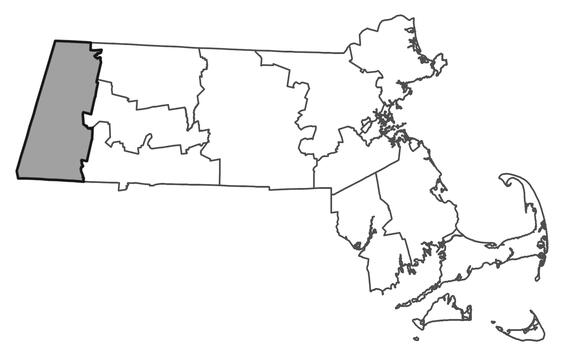- Scientific name: Chamaelirium luteum
- Species of Greatest Conservation Need (MA State Wildlife Action Plan)
- Endangered (MA Endangered Species Act)
Description
Devil’s-bit is a perennial herb of the lily family. Each plant produces a slender flower stalk from a basal rosette of spatulate-shaped green to pale-green leaves which arise from a thick, bitter-tasting tuberous root. The species is dioecious, bearing the pistillate (female) and staminate (male) flowers on separate plants. Male flower stalks grow up to a foot tall with a delicate raceme of small (3 mm; 1/8 in) creamy-white flowers nodding over at the top. The tiny stamens are yellow. Female flowers are up to two feet tall, straighter, and far less showy than the male flowers. All flowers have three petals and three sepals. Leaves on the flowering stalks are small and slender and stop short of the raceme.
The flowering season in Massachusetts occurs in late June and July. However, Massachusetts plants rarely flower so the rosette which grows flat on the ground is the only clue to its presence. This plant’s genus name is somewhat misleading as it was named from an immature, non-flowering specimen. It comes from the Greek chaimi, ground, and leiron, lily. Luteum refers to the yellow or creamy color that the male flowers appear to have towards the end of their flowering period until they dry out altogether. Fertilized female stalks (i.e., those that have developed seeds) often persist through the winter and into the following season.
Chamaelirium is a monotypic genus (having only one species). However, the rosettes of other plants can be mistaken for Chamaelirium luteum. The rosette of Clintonia borealis is similar to C. luteum. Both species are in the lily family, have parallel venation of their leaves, and can be found in acid woods. However, the leaves of Clintonia borealis are generally thicker, wider, and shinier than those of C. luteum. Also, C. borealis is more often found inhabiting cold moist woodlands.
Life cycle and behavior
Devil’s bit is a perennial herb that flowers in late June and July.
Population status
Chamaelirium luteum is listed as Endangered in Massachusetts. There have been four recent verified occurrences and three historical (prior to 1984) occurrences in the state. None of the plants observed in the past several years have flowered. As it is capable of tolerating a fairly wide pH range and can survive in a variety of habitats, it is unknown precisely why this species is so uncommon in Massachusetts. It is probable that, since this plant is dioecious and does not flower every year, it may be naturally incapable of rapid reproduction. Some tubers in one Massachusetts site appear to be undergoing vegetative reproduction (i.e., producing more than one rosette). More (but not full) sunlight and good drainage may allow the plants to flower more often. Chamaelirium luteum is also considered rare in Arkansas, Connecticut, Delaware, Illinois, Indiana, Louisiana, Maryland, New Jersey, and New York. It is possibly historic in Ontario. The MassWildlife’s Natural Heritage & Endangered Species Program database has 6 records from Berkshire County. Only 1 of these records has been observed within the last 25 years.
Distribution and abundance
Devil’s-bit ranges from southwestern Massachusetts to southernmost Ontario, southern Indiana, and southern Illinois, south to central Florida and eastern Louisiana. The species has declined greatly in the last 50 years throughout the northern portion of its range. The distribution of devil’s-bit was historically much wider in the Northeast than it is currently. Remaining populations occur in or near the Taconic Mountains where the borders of New York, Massachusetts, and Connecticut meet.

Distribution in Massachusetts
1999-2024
Based on records in the Natural Heritage Database
Habitat
In the southern United States, devil’s-bit is often found in mesic woods on well-drained slopes. In Massachusetts, one verified occurrence of the plant is found in young, shrubby, acidic woods with many small, shallow depressions on land that may formerly have been farmland which is now in the process of being reclaimed by forest. The devil’s-bit is found under a canopy of chestnut oak (Quercus montana), red maple (Acer rubrum), hemlock (Tsuga americana), and white pine (Pinus strobus). The understory is made up of mountain laurel and birch and beech seedlings. Devil’s-bit shares the forest floor with clubmosses (Lycopodium), shinleaf (Pyrola elliptica), Canada mayflower (Maianthemum americana) and others. A second verified site is atop a dry limestone ledge under sugar maple (Acer saccharum), white ash (Fraxinus americana), hop hornbeam (Ostrya virginiana), and white birch (Betula papyrifera).
Healthy habitats are vital for supporting native wildlife and plants. Explore habitats and learn about conservation and restoration in Massachusetts.
Contact
| Date published: | April 10, 2025 |
|---|